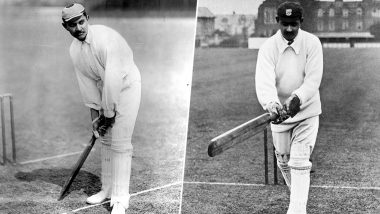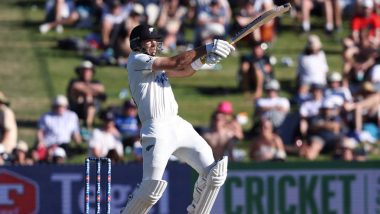Ranjitsinhji was one of the first pioneers of cricket in India. A Maharaja of his time and the first Indian to play for England, Ranjitsinhji would have celebrated his 147th birth anniversary on September 10, 2019. The Board of control for Cricket in India (BCCI) named the country’s premier domestic competition – Ranji Trophy – in the honour of late Ranjitsinhji, who is widely regarded as the greatest batsman of all time. Take a look at some rarely known things about the once king, who introduced new strokes to cricket and revolutionized the game. Sir Don Bradman Birth Anniversary: Some Lesser-Known Things to Know About Late Australian Cricket Star.
Ranji brought a new revolutionized batting technique to cricket and is also credited for introducing the leg glance, in which a batsman bends backwards and plays the ball behind the wicket on the leg side. But cricket was not everything Ranjitsinhji contributed to his society. As a maharaja of the Princely state of Nawanagar, Ranji looked after his subjects and was a popular and benevolent ruler. Happy Birthday, Sunil Gavaskar! Disliking Helmets to Writing Books, Here Are Five Lesser-Known Facts About the Former Indian Cricket Legend.
"A wonder and a glory departed from the game forever,” wrote Neville Cardus on Ranjitsinhji’s departure from cricket. Cardus, an English writer and critic described Ranjitsinhji as the Midsummer night's dream of cricket.” As we celebrate what would have been the great man’s 147th birth anniversary, let us look as some lesser-known facts of Ranjitsinhji.
A Name That Formed India’s First-Class Test Championship
The Ranji Trophy – which is the top-most first-class level domestic tournament of India – was named in honour of Ranjitsinhji. It is a known fact A.S. De Mello, founder of BCCI, agreed to the then Maharaja of Patiala, Bhupendra Singh’s, suggestion that the trophy is named after the late legendary Sir Ranjitsinhji Vibhaji Jadeja and agreed to sponsor it. But Ranji trophy will not have borne the name it has today, if Vibhaji, the Jam Sahib of Nawanagar, not disinherited his only son.
Ranjitsinhji was not a son of any king but was born to a farmer Jiwansinhji, who was related to the king of Nawanagar through Ranjitsinhji’s grandfather. Vibhaji disinherited his only son Kalubha due to his violent nature and adopted an heir to his throne. Upon the sudden death of the first heir, Ranjitsinhji was adopted as the official heir to the Nawanagar throne. Ranjitsinhji served as the Maharaja of Nawanagar from March 1907 to 1933.
Scorned for Being an Indian
Ranjitsinhji is often regarded as one of the greatest cricketers to have ever played the game and is also a pioneer of Indian cricket. But during his lifetime and even to date, Ranjitsinhji is often criticised for not contributing as a player to Indian cricket. He was offered the role of leading the Indian cricket team on his return from England, but Ranjitsinhji refused. But one thing that Ranjitsinhji faced as most Indians did in those days was being scored at for being an Indian.
When Ranjitsinhji moved abroad for further studies and enrolled in Cambridge University, he was enthralled by cricket. Having played some cricket back home in India, Ranjitsinhji impressed everyone at the Cambridge University net sessions and soon calls were made for him to be included in the first team. But Ranjitsinhji was left out by the then Cambridge captain Stanley Jackson, who later revealed that the reason he didn’t play Ranjitsinhji for more than a year was that Ranjitsinhji was an Indian.
This wasn’t, however, the end for Ranjitsinhji will face similar circumstances before his England debut and will be left out of the Test at Lord’s. The reason later given was that Lord Harris, the MCC Chairman and Principal England selector, did not want to field non-white players against Australia at Lord’s. But England lost the Test match and Ranjitsinhji was played in the second game. He replied with a fifty and a debut Test century – Steve Smith would have been proud.
Sussex County Cricket Club Legend
Sussex County Cricket Club, which plays in the top-tier of the domestic cricket structure of England, has listed K S Ranjitsinhji as one their notable players – who have made a significant contribution to the club’s rich history – and club legend. Ranjitsinhji also holds the record of scoring Sussex club’s highest partnership for the seventh-wicket. Ranjitsinhji and Billy Newham – former England international – registered a record 344-run partnership for the seventh-wicket against Essex in 1902. The club record still stands to date.
In 307 appearances for Sussex, Ranjitsinhji scored an astonishing 24, 692 runs, which comprised of 72 centuries and 109 fifties. He had a batting average of 56.37 and the highest score of 285. Ranjitsinhji was also named one of the Wisden Cricketers of the Year in 1896 and the highest run-scorer in three County Championship seasons (1896, 1899 and 1900).
Played and Captained a Team Named after Him
How many players do you know that played and captained a team named after himself? Most had tournaments and series named in their honour after they had retired. But Ranjitsinhji was special. Not only did he play for the team, which was named Ranjitsinhji XI, he also captained them when they toured North America to play Philadelphian Gentlemen.
Ranjitsinhji led the team – named in his honour – in two matches and won both. He also scored half-centuries in the two innings he batted in that tour. This was later described as a plan hatched by Ranjitsinhji to show his captaincy potential to the England selectors and eventually become the captain of the English cricket team, which was his unfulfilled dream.
Ranjitsinhji’s Nephew Duleepsinhji Has an Indian Domestic Competition Named after Him
When Ranjitsinhji turned 48 – having already lost an eye to a tragic accident – he had already passed his prime and therefore bid adieu to cricket in England and returned back to India, a disappointed man. But in India, he established another legacy that the country will never forget. Ranjitsinhji was overjoyed when he found that his nephew Duleepsinhji had an ardent interest in cricket.
He took Duleepsinhji under his wing and developed the youngster as a cricketer. Duleepsinhji would later follow Ranjitsinhji’s footsteps and start his career in Cambridge. He would also go on to play international cricket for England – the second Indian after Ranjitsinhji to do so – and even had a better Test record than his uncle.
Duleep made three hundreds and five half-centuries in 12 Test matches before frequent illness cut his career short. The Duleep Trophy is played by teams hand-picked and shortlisted by BCCI and currently has three teams – India Blue, India Green and India Red – India Red are the defending champions.
(The above story first appeared on LatestLY on Sep 10, 2019 08:30 AM IST. For more news and updates on politics, world, sports, entertainment and lifestyle, log on to our website latestly.com).













 Quickly
Quickly




















